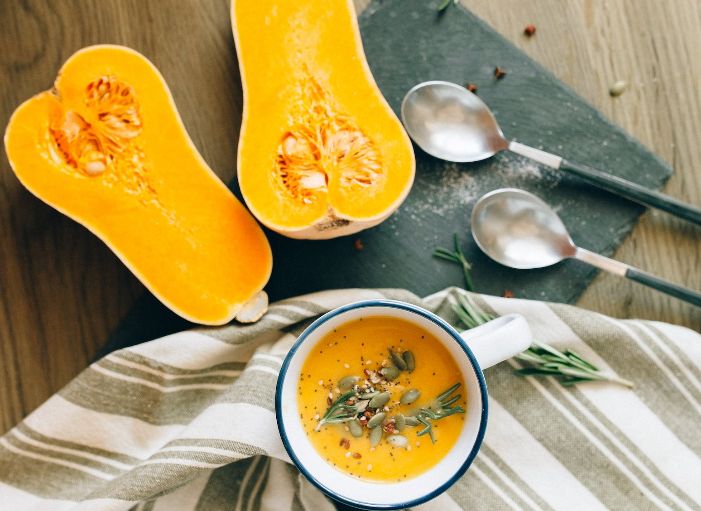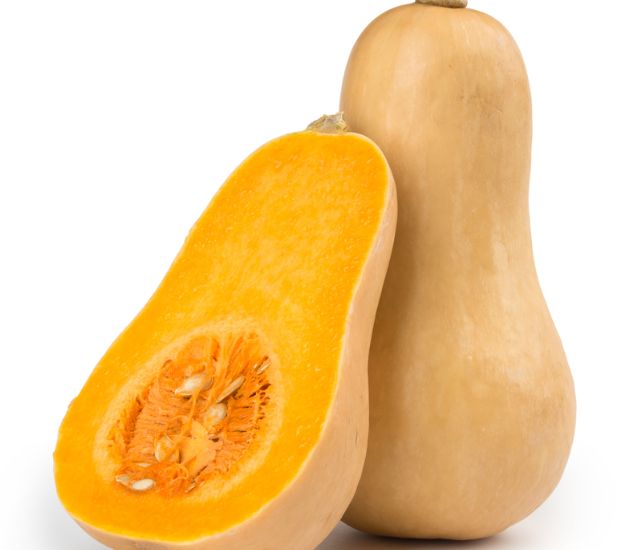

A Few Facts About Butternut Squash
Butternut squash is a winter squash that’s available all year long, and peaks during the fall and winter months. It also goes by the name Cucurbita Moschata and is part of the gourd family, which includes spaghetti squash, acorn squash, and crookneck squash. On the outside, butternut squash is tan, oblong-shaped, and may not look like much. But inside it’s bright orange and is full of nutrients. This winter squash has a nutty taste and is naturally sweet. Its texture and flavor lends itself well to roasting, soups and stews.
Keep reading to find out about possible nutrition and health benefits of eating butternut squash, and different ways you can include these gourds in your diet.
Nutrient-Rich Food
Butternut squash is versatile and loaded with nutrients. It is a great source of fiber, potassium, Vitamin A, Vitamin C and other important vitamins and minerals. A 1-cup serving of cooked butternut squash has more than 100% of the Reference Daily Intake (RDI) for Vitamin A. So you will get all of the vitamin A that you need in one serving.
High in Potassium
Butternut squash is rich in potassium. A 1 cup serving has a whopping 582 mg of potassium. Its potassium content is comparable to eating a medium potato (515 mg), a medium sweet potato (347 mg), or an orange (232 mg). Potassium supports heart health, because it helps to manage blood pressure. Studies have shown that using less salt in addition to eating more potassium rich foods can reduce cardiovascular risk. Unless you have diet restrictions, if you are looking for ways to increase your potassium intake, add butternut squash to that list. Anyone that’s on a potassium restricted diet or has kidney disease may need to limit the amount of potassium that they consume on a daily basis.
Supports Digestive Health
Butternut squash is an excellent source of soluble and insoluble fiber. The insoluble fiber helps to move food along the digestive tract. This helps to add bulk to stool, increase the frequency of bowel movements, and prevent constipation, which supports good digestive health.
Stabilizes Blood Sugar
The fiber in butternut squash may help to stabilize blood sugar levels, by slowing the absorption of sugar during the digestive process. It can also limit blood sugar spikes after eating meals. It is a low glycemic food which is beneficial for individuals with diabetes, or those at risk of developing the condition.
Weight Management
It is low in calories and high in fiber, making it an excellent choice for those that are looking to manage their weight. It contains fewer calories than carbohydrates like pasta, rice and bread.The fiber it contains also helps you to feel full and satisfied for longer.
Contains Antioxidants
It is rich in vitamin A, an antioxidant that protects your cells from free radical damage. It neutralizes the effect of these foreign bodies in your body ,so that healthy cells are not harmed. Free radical damage can lead to premature aging, an increased risk of age-related chronic health conditions, and cancer.

Tips on Buying and Storing Butternut Squash
- Choose one that is firm to the touch, and feels heavy for its size.
- Avoid buying butternut squash with any visible signs of spots, blemishes or mold. A squash with these imperfections will have a shorter than usual shelf life.
- Store it in a cool and dark place.
- The average shelf life for butternut squash is around 1 – 3 months.
- Cut and uncooked butternut squash can keep in the refrigerator for 3-5 days if it is stored in a sealed food storage container.
- To extend the shelf life of butternut squash even more, you can freeze it. Peel it, cut it into cubes, then spread it out on a baking sheet before placing it in the freezer. Once the pieces have frozen solid, transfer them to ziploc bags. Using this method, butternut squash can be kept in the freezer for 6 months or more.

How to Use Butternut Squash
- Cut it into cubes along with beets, carrots, parsnips and other root vegetables and roast them on a baking sheet. Add seasonings and drizzle some olive oil on it. Here is a recipe for roasted rainbow veggies that includes butternut squash (or any type of squash) with a variety of colorful vegetables. It is a tasty and nutritious side dish that also happens to be plant-based.
- Add pureed butternut squash to macaroni and cheese for a tasty butternut mac and cheese dish.
- Prepare mashed butternut squash instead of the usual mashed potatoes. Just bake or boil the squash, then mash it and add butter or olive oil, salt, pepper and seasonings.
- Stir in cubed butternut squash in curries, beans, stews, even chili.
- Use it as a main dish and prepare butternut squash soup. Combine and blend squash, broth, herbs, spices and heavy cream or coconut milk (if vegan) for a creamy and velvety soup.
- Stuff butternut squash halves with wild rice, lentils onions, peppers and spices, before roasting it.
- Use puréed butternut squash in recipes for pumpkin bread or muffins.
- Add some roasted butternut squash cubes to your salad for a heartier and more nutritious meal.
Butternut squash can make a delicious and healthy side to your favorite meal, so give it a try.
Sources:
1. FoodData Central. fdc.nal.usda.gov. https://fdc.nal.usda.gov/fdc-app.html#/food-details/169296/nutrients.
2. Jwatch.org. https://www.jwatch.org/na54360/2021/12/27/sodium-potassium-and-cardiovascular-disease.
3. Fiber: The CARB that helps you manage diabetes. Centers for Disease Control and Prevention. June 20, 2022. https://www.cdc.gov/diabetes/library/features/role-of-fiber.html.
4. Sapna. Roasted Rainbow Veggies. A Li’l Bit of Spice. Published March 17, 2021. https://alilbitofspice.com/roasted-rainbow-veggies/.